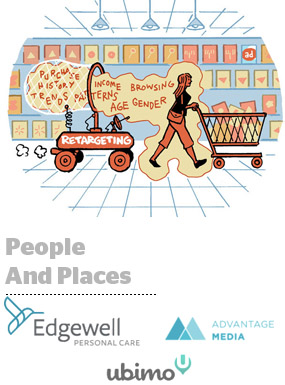
Where a person goes can be used as a solid signal of intent, but that signal gets stronger and more predictive when location is combined with shopper marketing data.
Although the insights aren’t always intuitive, they’re always useful, said Kim Riedell, a Digilant vet and SVP of Advantage Media, the media-buying arm of Advantage Solutions, a multibillion-dollar retailer-focused sales and marketing agency.
“Say we know that a person has been to the dog park, to a pet store and also likes to go to baseball games and visit soccer websites,” Riedell said. “We can capture that information in our DMP and use it to get people into a store.”
On Wednesday, Advantage Media formalized its partnership with Ubimo, a location-based ad company, to ingest more location data into its proprietary data management platform, MomentAware. The DMP also houses retail purchase data and past purchase data flowing in from Advantage retailer and brand clients, like Edgewell Personal Care, parent company to Hawaiian Tropic, Banana Boat, Schick razors, Playtex and other consumer product brands.
The result is a shopper marketing graph hinged on location data, said Ubimo COO Gilad Amitai.
“We customized our data science team and algorithms to look into parameters we hadn’t looked at before,” Amitai said. “A generic graph might tell you something like, ‘This person visits Walmart, lives in this ZIP code, works in that ZIP code and after a visit to Walmart, they go to McDonald’s.’ By bringing in shopper data we can identify whether the person is loyal, sporadic or lapsed and layer in data like when the person goes shopping, what they buy and average basket size combined with location.”
Edgewell has been experimenting with location data for several years. In a campaign to promote sun care education related to its sunscreen products, Edgewell used Advantage Media to serve programmatic digital and social ads based on local weather targeted at four outside activities that people often don’t bother to use sunscreen for: running, gardening, outdoor entertaining and hiking. Store locators and coupons rounded out the experience.
The company’s location-based marketing efforts have evolved from there.
“We need to be able to understand what someone is doing,” said Jonathan Rhyan, senior manager of shopper marketing at Edgewell Personal Care. “Is somebody preparing to go into a store? Have they just come out? That makes a difference.”
It’s also about knowing what else consumers are up to when they’re not in or near a store and pairing that with shopper data and demographic data.
“Sunscreen in particular is a very activity-based category, so understanding where people go from day to day or whether they’re about to embark on an outdoor activity is important to us,” Rhyan said. “That has an impact on who we’re looking to reach out to and on how we then decide to message them.”
Edgewell’s men’s shave business, which includes Schick and Edge, for example, is targeted at a very particular psychographic profile. Being able to figure out the activities this profile engages with enables Edgewell to target or retarget consumers when they’re near a particular movie theater, say, or a sporting event.
“The creative we deliver can be more relevant based on their interests while also marrying the brand with their passion point as they’re in a specific place or engaging in a particular activity,” Rhyan said.
These are what Advantage Media refers to as “receptive moments.”
“Location-based data plus intent equals a receptive moment, the moment when someone is more receptive to see an ad and then buying a product later on,” Riedell said.
But beyond the targeting aspect, Ubimo and Advantage are also able to use their combined data assets to do store-level attribution. Although they can’t tell whether a specific person who saw an ad walked into a store and bought a product, Ubimo knows how many impressions were served around a particular location and Advantage Media has insight into how many products moved off the shelf.
“Even if we’re not closing the loop on the device or the specific credit card, we can do it in a specific store,” Amitai said. “And by applying A/B testing and using control groups, we manage to find out which audiences are driving better sales than others.”
This post was syndicated from Ad Exchanger.

More Stories
Netflix Sets Up Killer You Marketing Activation With Penn Badgley
5 Ways Brands Can Weather a Tariff Storm as Consumer Spending Shifts Toward Value
Creativity shines